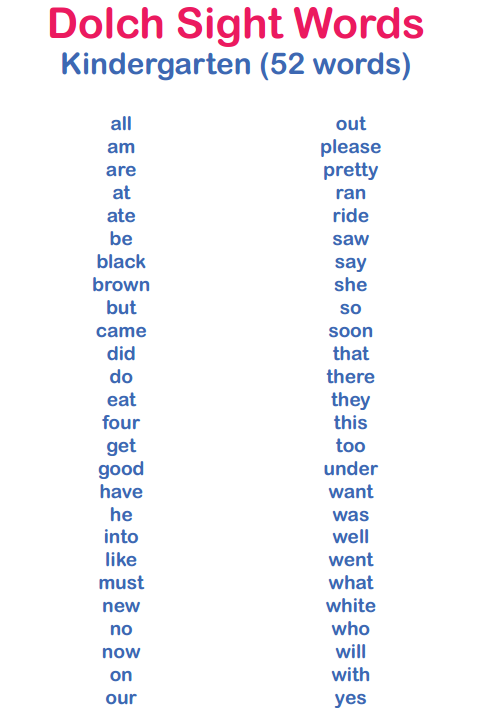sight words kindergarten
Sight words for kindergarten are frequently occurring words that kids learn to recognize quickly. They help build reading fluency and comprehension, focusing less on decoding and more on meaning. Examples include “the,” “and,” “is,” and “in.”
- Sight words kindergarten PDF
- Buy sight words kindergarten
- Ask AI anything about sight words kindergarten
- Related websites
sight words kindergarten PDF

all, am, are, at, ate, be, black, brown, but, came, did, do, eat, four, get, good, have, he, into, like, must, new, no, now, on, our, out, please, pretty, ran, ride, saw, say, she, so, soon, that, there, they, this, too, under, want, was, well, went, what, white, who, will, with, yes
all, am, are, at, ate, be, black, brown, but, came, did, do, eat, four, get, good, have, he, into, like, must, new, no, now, on, our, out, please, pretty, ran, ride, saw, say, she, so, soon, that, there, they, this, too, under, want, was, well, went, what, white, who, will, with, yes
(52 words in total)
Buy sight words kindergarten
BOB Books SIGHT WORDS COLLECTION Book Box Set [Kindergarten & First Grade]: https://amzn.to/3Va0vK9
Ask AI anything about sight words kindergarten
-
Kindergarten sight words: went
“Went” is a sight word that is commonly taught in early reading education. It is the past tense form of the verb “go.” Sight words like “went” are important because they appear frequently in texts and recognizing them quickly helps with reading fluency.
### References:
– Dolch, E. W. (1948). *Problems in Reading*. Champaign, IL: Bureau of Educational Research, University of Illinois.
– Fry, E. B., & Kress, J. E. (2006). *The Reading Teacher’s Book of Lists* (5th ed.). Jossey-Bass.
-
Kindergarten sight words: well
“well” is a common sight word that appears frequently in reading and writing. It can function as an adverb, adjective, or interjection. Here are some examples of its usage:
1. **Adverb**:
– She sings **well**.
– He did **well** on the test.2. **Adjective**:
– I am feeling **well** today.
– The patient is **well** enough to go home.3. **Interjection**:
– **Well**, what do you think?
– **Well**, that’s surprising!For educational purposes, “well” is often included in lists of high-frequency words that students should recognize on sight to improve their reading fluency.
References:
– Fry, E. B., & Kress, J. E. (2006). *The Reading Teacher’s Book of Lists* (5th ed.). Jossey-Bass.
– Dolch, E. W. (1948). *Problems in Reading*. Southern Illinois University Press.
-
Kindergarten sight words: was
“Was” is a sight word. It is one of the most common verbs in the English language and is used to indicate past tense. Sight words like “was” are typically learned through memorization because they do not always follow phonetic rules and are essential for reading fluency.
### References:
1. **Fry, E. B., & Kress, J. E. (2006).** *The Reading Teacher’s Book of Lists (5th ed.).* Jossey-Bass.
2. **Dolch, E. W. (1948).** *Problems in Reading.* Southern Illinois University Press.
- Kindergarten sight words: the
- Kindergarten sight words: with
- Kindergarten sight words: will
- Kindergarten sight words: who
- Kindergarten sight words: white
- Kindergarten sight words: what
- Kindergarten sight words: went
- Kindergarten sight words: well
- Kindergarten sight words: was
- Kindergarten sight words: want
- Kindergarten sight words: under
- Kindergarten sight words: too
- Kindergarten sight words: this
- Kindergarten sight words: they
- Kindergarten sight words: there
- Kindergarten sight words: that
- Kindergarten sight words: soon
- Kindergarten sight words: so
- Kindergarten sight words: she
- Kindergarten sight words: say
- Kindergarten sight words: saw
- Kindergarten sight words: ride
- Kindergarten sight words: ran
- Kindergarten sight words: pretty
- Kindergarten sight words: please
- Kindergarten sight words: out
- Kindergarten sight words: our
- Kindergarten sight words: on
- Kindergarten sight words: now
- Kindergarten sight words: no
- Kindergarten sight words: new
- Kindergarten sight words: must
- Kindergarten sight words: like
- Kindergarten sight words: into
- Kindergarten sight words: he
- Kindergarten sight words: have
- Kindergarten sight words: good
- Kindergarten sight words: get
- Kindergarten sight words: four
- Kindergarten sight words: eat
- Kindergarten sight words: do
- Kindergarten sight words: did
- Kindergarten sight words: came
- Kindergarten sight words: but
- Kindergarten sight words: brown
- Kindergarten sight words: black
- Kindergarten sight words: be
- Kindergarten sight words: ate
- Kindergarten sight words: at
- Kindergarten sight words: are

![BOB Books SIGHT WORDS COLLECTION Book Box Set [Kindergarten & First Grade]](https://kindergartensightwords.com/wp-content/uploads/2024/12/BOB-Books-SIGHT-WORDS-COLLECTION-Book-Box-Set-Kindergarten-First-Grade.jpg)
